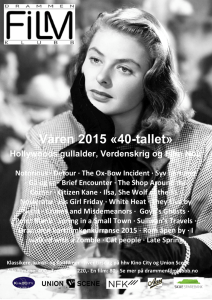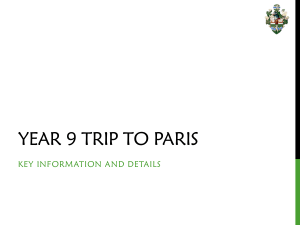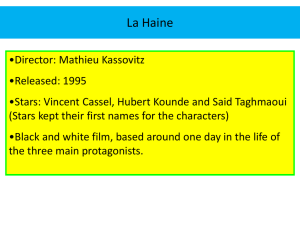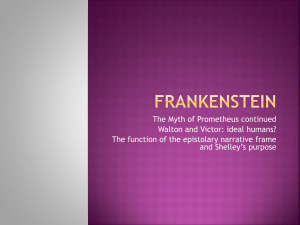File - Miss O` Connell`s English Class
advertisement
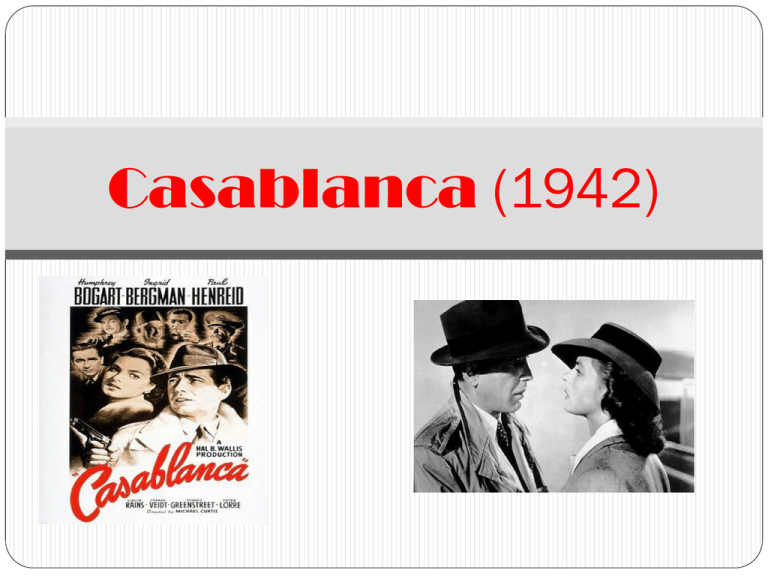
Casablanca (1942) Key information Directed by Michael Curtiz Starring: Humphrey Bogart – Rick Blaine Ingrid Bergman – Ilsa Lund Paul Henreid – Victor Laszlo Warner Bros. Release date: November 1942 Context and Setting The film is set in Casablanca, Morocco in the early days of the Second World War. During WWII many people were displaced from their countries, wither to fight or fleeing persecution (Victor Laszlo) In a geographical sense, the choice of Casablanca as a setting is essential to the way that the narrative develops, as all the characters are, in a way visitors there. Casablanca’s connection to France, but geographical distance, means that the representatives of Vichy France, the Resistance, and the Nazi Party behave in ways that would not have been possible elsewhere – they are forced to co-exist resulting in moments of tension and danger. Casablanca: Characters Rick Blaine Ilsa Lund Victor Laszlo Captain Renault Strasser Rick Blaine: “Before…” Rick Blaine, the cynical owner of Rick's Café Americain, often appears too jaded to be impressed or moved by anyone. He refuses to accept drinks from customers, treats his lover Yvonne without affection or respect, and seems not to care that a war is being waged around him or that desperate refugees have flocked to Casablanca. He makes a point of broadcasting his isolation, stating on several occasions, "I stick my neck out for nobody.“ Rick Blaine: Behind the cynical mask However, another Rick lurks behind his façade of cynicism. Near the beginning of the film, he refuses entry to the bar's private back room to a member of the Deutsche Bank, even though other, less prominent people are allowed in—a clue that despite his proclaimed apathy, his political sympathies lie with the Allies. Louis calls him a sentimentalist, and we learn that before coming to Casablanca, Rick was involved in political causes, supporting losing sides against fascist aggressors in Spain and Ethiopia. From the opening scene, Rick shows himself to be a mysterious and complicated man—tense, solitary, and self-involved, but also generous, discriminating, and perhaps a political partisan. Rick Blaine: “Richard” .As though to emphasize how different he is in Paris, he is called Richard, not Rick, in all the flashback scenes. Though Rick and Ilsa plan to leave Paris together after the Nazis' arrival, Ilsa stands Rick up at the train station, and this painful separation helps explain how the optimistic Richard became the aloof, cynical Rick we see at the beginning of the film. Rick is not cold-hearted, but he suffers from heartbreak. When Ilsa appears at the bar, Rick initially reacts angrily and refuses to give her and Laszlo the letters of transit. By the end of the film, he acts heroically, sacrificing both a possible future with Ilsa and his comfortable life in Casablanca so that Laszlo can escape with Ilsa and continue his important political work. Rick, Rick and Richard… In effect, three Ricks appear in the movie. In Paris, he is a romantic innocent. In Casablanca, a jaded, hard-hearted businessman By the end of the film, a committed, self-sacrificing idealist. Idealist = a person who cherishes or pursues high or noble principles, purposes, goals, etc. Ultimately, Rick's story remains incomplete. A dark mystery from Rick's past prevents him from returning to his native America, and though we learn much about him, we never learn why he can't go home. The theme of Forbidden Love -A type of love considered taboo. This could be where two people love each other but is morally, ethnically or legally wrong -Forbidden love is when two people love each other, but are afraid to unite because of a conflict. One conflict can be that their peers or family does not accept the fact that the two people love each other -Another definition of forbidden love is when there is passion that belongs but can’t be expressed Throughout time, courtly love and romance has been a topic found in literature. Sometimes love is forbidden between two people. These types of love stories are intriguing and provocative and they divide people with opinions of what is right or wrong. Reasons for love to be “forbidden” Many reasons attribute to why love is forbidden. These reasons can include; social class, feuding families, a love triangle, homosexuality. The theme if forbidden love is often found in novels from the 19th Century and still appears in novels today Common themes of forbidden love in literature: The lovers come from two different religions. The lovers come from two opposing ethnic groups. One of the people in a relationship has an affair with another person. There is a huge age difference between the two lovers. One or both of the loves may be in relationships. Key Scene 1 Victor and Ilsa arrive at Casablanca –What is Rick’s reaction? • Does Rick change persona due to this arrival? • How do Ilsa and Rick act in each other’s presence? • What does Ilsa tell her husband when they leave Rick’s? Notes on Key Scene 1 Ilsa’s reaction to Sam hints to the fact that they know each other. She, firstly, wants to leave. Victor believes this is because she feels unsafe, she, however, is fearing her past. Ilsa then becomes inquisitive, asking about “the boy at the piano” and then who Rick is. Ilsa approaches Sam. Her past is alluring to her. “As Time Goes By” ; Rick and Ilsa’s love anthem hasn’t been played in a “long time” ==> Rick hasn’t loved in a long time Ilsa tears up – a gesture that she is thinking fondly of the past. Lazslo seems an obstacle to a proper reunion between the pair. Rick respects him and this is obvious in this scene. Key Scene 2 Rick (“Richard”) and Ilsa in Paris Notes on Key Scene 2: Love that is not forbidden – in Paris. Symbols of love – champagne, flowers (Rick wears one in his lapel), dancing. They have a pact, a bond, not to reveal their pasts. They have fallen in love in Paris: they are both starting afresh. Ilsa alludes to a man in her past life. La Belle Aurore = beautiful sunrise “Here’s looking at you, kid!” ==> “I love you” Rick oblivious to his own danger – so in love! “Kiss me...” ==> intensity of their relationship Champagne spills ==> ruination of relationship in eminent Key Scene 3 Rick receives the letter at the train station How does Rick react? What are the consequences of Ilsa’s letter? Notes on Key Scene Three Rain pours down (just like the spilt champagne) which creates an ominous atmosphere. Isla’s note: “...just believe that I love you”. Rain represents his tears, the roar of the train represents his anger. Rick throws letter away, throws Ilsa and love away. Key Scene 4 Isla’s first late-night visit to Rick’s Why does she visit him? What has their relationship become? Describe their personalities in this scene. Notes on Key Scene Four Returning to the present – at Rick’s. Ilsa appears behind Rick’s bourbon bottle. He has been using alcohol to replace her. Rick remembers ever day of their time together. Ilsa’s eyes brim with tears as he rejects her visit and wallows in self-pity. She recounts of a time when she immigrated from Oslo to Paris in the 1930s. She feel for Victor with a feeling she “supposed was love”. When she met Rick she realised it was love. No ifs, buts or supposing! Rick dismisses her – he reacts badly which shows highlights the cracks in his outer shell. She continues to hurt him. Key Scene 5 Rick meets Ilsa at the market Notes on Key Scene 5 Rick greets Ilsa at a market stall (...tail between his legs...) His tie matches her top – they is still a connection. Ilsa seems aloof and hurt. She fears the “hatred” in his eyes. Rick foresees that she will return to him which sparks Ilsa’s revelation. He is astounded to hear that Isla had been married to Victor when he courted her in Paris.... This scene is a stark contrast from their time in Paris, filled with flowers and champagne. They are also alone in this scene. Rick sees no obstacle in their love, Ilsa thinks otherwise!. Key Scene 6 Rick and the young Bulgarian lady. What aspect of Rick’s character does this scene highlight? Another example of Romantic Love vs Forbidden Love Rick states to Annina that nobody ever loved him that much. Here Annina is grappling with the notion of partaking in a forbidden love affair with Captain Renault to ensure a life in America for herself and Jan. When Rick helps Jan and Annina it is clear that he does not promote this type of hidden, illicit love. It is dangerous. Rick refers to Jan as a “lucky guy” as he is truly loved by his wife. Rick sees himself as unlucky as his relationship with Ilsa did not end with Lady Luck on their side. Key Scene 7 Ilsa’s second visit late-night to Rick. She declares her love but also holds him at gunpoint Does Ilsa really love Rick, or is she just feigning love to secure tickets of transit for herself and Victor? Notes on Key Scene 7 NB: The censorship code in American in the 1940s was very strict. By the 1920s the American TV, films and shows were a frequent source of explicit screen material, had topless shows, performances filled with curse words, mature subject matters, and sexually suggestive dialogue. An amendment to the Code, adopted on June 13, 1934, established the Production Code Administration (PCA) and required all films released on or after July 1, 1934, to obtain a certificate of approval before being released. Therefore this scene between a married Ilsa and Rick is brief. BUT! The audience can still pick up on the passion between the pair in comparison to the “paternal kiss” given to Ilsa by Victor in the previous scene. Champagne returns – a symbol of their relationship rekindling. Ilsa married Victor before she had any experience of life. When she fell for Rick it was too late – their relationship was forbidden. Isla tries to overcome the forbidden nature of their love. She wants Rick to care for her. “Here’s looking at you, kid” – Rick says, without smiling. He notes their love is still forbidden. Key Scene 8: The Airport Finale! Note the body language of Rick and Ilsa…. Ilsa clutches Victor as she is unsure of her future She is a background figure in this scene and helpless of what lies ahead for her… She cries silently into a tissue – why? Notes on Key Scene Eight In this scene we learn that Rick and Ilsa have to put the good of the Resistance before their own cause – love. Their love remains forbidden and Rick acknowledges this by the fact that he signs the Laszlo’s name on the letters of transit. Ilsa tries to fight against his decision. She cries silently in the background. To ensure she is happy in her future life Rick reassures Victor by inventing a false-story about Ilsa visiting him Not a romantic “happily ever after”... “Louis, I think this is the beginning of a beautiful friendship.” What feelings are we left with for both Rick. Ilsa and Victor at the end of the film? Analysis of Key Scenes How is the theme introduced in this key moment? How is the theme developed in this key moment? How does the action of the scene advance the theme in this key moment? How does the behaviour of the characters advance the theme? Essay One: Forbidden Love Write an essay on the theme of Forbidden Love in “Casablanca”. Intro Parg 1 Parg 2 Parg 3 Conclusion Use Youtube clips to revise the film OR Quote sheet AND Class notes! Introduction Link to what has been asked of you in the question. Definition of forbidden love and where it is seen in the film, “Casablanca”, directed by Michael Curtiz. Parg. 1 Flashback to Paris: we see a love that is not forbidden. True love, meant to me. Not challenged by people or society The past does not haunt them. Symbols of Love – flowers, champagne... etc Parg. 2 Forbidden Love = obstacles : what gets in the lovers way Obstacle 1: Flashforeward we realise that Victor is the chief obstacle: Isla is married. Discuss the history of their marriage. How she married him when she thought she loved him “supposed was love”... / How he was thought dead / How he returned “back to life” when she was in Paris. Parg 3 Rick and Ilsa’s alone time. A connection is seen: long stares, eyes brimming with tears, co-ordinated and passionate kisses. Victor’s relationship with Ilsa is not intense. Ilsa’s second late night visit = challenges their forbidden love and gives into temptation – hope that their love will blossom. Parg 4 Obstacle 2: The right cause! The Resistance fight against the oppression and suffering caused by the Nazi and Vichy regimes. However, for Victor’s pro-Ally mission to succeed he, along with the people around him, are obliged to sacrifice part of themselves. Rick is pro-Ally and acknowledges that Victor needs Ilsa to succeed in his goals. Rick and Ilsa both sacrifice their love for a greater cause. Detailed analysis of Rick Analyse in detail, the 6 key scenes. What representation of masculinity is presented? Consider: the director’s use of mise en scene interaction with other characters where Rick is positioned in the ‘frame’ use of lighting dialogue In conclusion: (a) What makes him such an interesting character? (b) How Rick manages to retain control of each scene? Rick Blaine Rick Blaine, the cynical owner of Rick's Café Americain, often appears too jaded to be impressed or moved by anyone. He refuses to accept drinks from customers, treats his lover Yvonne without affection or respect, and seems not to care that a war is being waged around him or that desperate refugees have flocked to Casablanca. He makes a point of broadcasting his aloofness, stating on several occasions, "I stick my neck out for nobody." However, another Rick lurks behind his façade of cynicism. Near the beginning of the film, he refuses entry to the bar's private back room to a member of the Deutsche Bank, even though other, less prominent people are allowed in—a clue that despite his proclaimed apathy, his political sympathies lie with the Allies. He also criticizes the criminal Ugarte for charging refugees too much for exit visas. Shortly thereafter, Louis calls him a sentimentalist, and we learn that before coming to Casablanca, Rick was involved in political causes, supporting losing sides against fascist aggressors in Spain and Ethiopia. From the opening scene, Rick shows himself to be a mysterious and complicated man—terse, solitary, and self-involved, but also generous, discriminating, and perhaps a political partisan. When Ilsa arrives in Casablanca, we start to understand some of Rick's mysterious past. In a flashback to his time in Paris, we see a younger, happier, lighter Rick in love with Ilsa. As though to emphasize how different he is in Paris, he is called Richard, not Rick, in all the flashback scenes. Though Rick and Ilsa plan to leave Paris together after the Nazis' arrival, Ilsa stands Rick up at the train station, and this painful separation helps explain how the optimistic Richard became the aloof, cynical Rick we see at the beginning of the film. Rick is not coldhearted, but he suffers from heartbreak. When Ilsa appears at the bar, Rick initially reacts angrily and refuses to give her and Laszlo the letters of transit. By the end of the film, he acts heroically, sacrificing both a possible future with Ilsa and his comfortable life in Casablanca so that Laszlo can escape with Ilsa and continue his important political work. In effect, three Ricks appear in the movie. In Paris, he is a romantic innocent; in Casablanca, a jaded, hardhearted capitalist; and by the end of the film, a committed, self-sacrificing idealist. Ultimately, Rick's story remains incomplete. A dark mystery from Rick's past prevents him from returning to his native America, and though we learn much about him, we never learn why he can't go home Discuss the following images of Ilsa. How is she represented? Ilsa’s role When asked in an interview about Ilsa (Ingrid Bergman), the director, Micheal Curtiz said: “She is the nexus of power in the film. It is only with respect to her that Rick shows any vulnerability and humanity. There is a strength in her not to be underestimated. She doesn't just follow along. She comes to meet Rick at night, she does things, she transgresses some borders, and she shows her feelings. She might be the most honest of the film's characters. She is the fuel that drives the narrative forward, and she is worth it. I think the female aspect of the film is very strong, although she is almost the only woman in the film. Otherwise, the film portrays a very masculine universe.” Do his comments make you reconsider your reading of Ilsa? Give reasons. Ilsa Lund Ilsa is fiercely loyal to her husband, Laszlo, and the political cause—resistance to the Nazis—he represents, but the truth of her sentiments is constantly suspect. She claims to love Laszlo, but she also claims to be in love with Rick, both in Paris and in Casablanca. We might suspect that Rick is her great passion and that only circumstance and political necessity prevent their union, but Ilsa never makes the distinction clear. She has good reason to tell Rick she loves him in Casablanca, since she needs the letters of transit he holds - logical ulterior motives. The letter she sent to Rick in Paris so many years ago, saying she could never see him again, is evidence of her ability to shield her true feelings from those who love her the most. Ilsa Lund Ilsa clearly has suffered more than any other character in Casablanca. First, her husband is arrested and rumoured to be dead. When he reappears, she must run with him throughout Europe with the Nazis always on their heels. She meets Rick and falls in love, only to have to leave him, then meets him and perhaps falls in love with him again, only to leave him once more. No matter whom she truly loves, she has not had an easy life, and her fate is the most tragic in the film. At the airport we can see that for Ilsa, the possibility of a happy ending does not exist. Ilsa herself may not even know what her own happiness would entail Victor Laszlo Victor is the hero of the film. Clue is in his name – “Victor” =victory, victorious! He is the pure embodiment of the noble hero, as a good as any man can be. Laszlo is handsome, confident, idealistic, outspoken, unwavering, and impassioned. He is married to the beautiful Ilsa, and he loves his wife so much that when he learns about Ilsa and Rick, he claims to understand. He is willing to sacrifice himself so that Ilsa can escape Casablanca safely.Yet Laszlo's true love is politics. The desire to defeat the Nazis is the prime motivation for all his actions. Laszlo is a symbol of the resistance. He represents unwavering commitment, a quality that makes him as valuable to the Allies as he is dangerous to the Nazis. Ilsa:You’re saying this only to make me go. Rick: I’m saying this because it’s the truth Inside of us, we both know you belong with Victor.You’re part of his work, the thing that keeps him going. If that plane leaves the ground and you’re not with him, you’ll regret it, maybe not today, maybe not tomorrow, but soon and for the rest of your life . Ilsa, I’m no good at being noble, but it doesn’t take much to see that the problems of three little people don’t amount to a hill of beans in this crazy world. (21) In this single statement, the affirmation of collective goals, ahead of individual needs and desires, is proclaimed. In war time – as in eras of peace – there are more significant cultural forces than love. In the end, Rick is the noble protagonist who embodies the need to fight oppression, the responsibility involved in struggle and the personal losses necessary for a greater cause.
